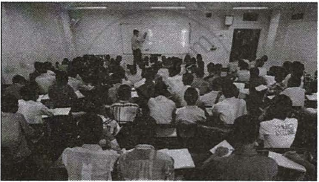Advertisements
Advertisements
प्रश्न
Find the value of k for which each of the following system of equations has infinitely many solutions
kx - 2y + 6 = 0
4x + 3y + 9 = 0
उत्तर
The given system of equation is
kx - 2y + 6 = 0
4x + 3y + 9 = 0
The system of equation is of the form
`a_1x + b_1y + c_1 = 0`
`a_2x + b_2y + c_2 = 0`
Where `a_1 = k, b_1 = -2,c_1 = 6`
And `a_2 = 4, b_2 = -3,c_2 = 9`
For a unique solution, we must have
`a_1/a_2 = b-1/b_2 = c-1/c_2`
`=>k/4 = (-2)/(-3) = 6/9`
Now
`k/4 = 6/9`
`=> k/4 = 2/3`
`=> k = (2xx4)/3`
`=> k = 8/3`
Hence, the given system of equations will have infinitely many solutions, if `k = 8/3`
APPEARS IN
संबंधित प्रश्न
Find the value of k for which the system
kx + 2y = 5
3x + y = 1
has (i) a unique solution, and (ii) no solution.
Determine the values of a and b so that the following system of linear equations have infinitely many solutions:
(2a - 1)x + 3y - 5 = 0
3x + (b - 1)y - 2 = 0
Solve for x and y:
x + y = 3, 4x – 3y = 26
Solve for x and y:
`x + 6/y = 6, 3x - 8/y = 5`
Show that the following system of equations has a unique solution:
3x + 5y = 12,
5x + 3y = 4.
Also, find the solution of the given system of equations.
The sum of the digits of a two-digit number is 12. The number obtained by interchanging its digits exceeds the given number by 18. Find the number.
The present age of a man is 2 years more than five times the age of his son. Two years hence, the man’s age will be 8 years more than three times the age of his son. Find their present ages.
On selling a tea-set at 5% loss and a lemon-set at 15% gain, a shopkeeper gains Rs. 7. However, if he sells the tea-set at 5% gain and the lemon-set at 10% gain, he gains Rs. 14. Find the price of the tea-set and that of the lemon-set paid by the shopkeeper.
A man has some hens and cows. If the number of heads be 48 and number of feet by 140. How many cows are there.
Read the following passage:
|
A coaching institute of Mathematics conducts classes in two batches I and II and fees for rich and poor children are different. In batch I, there are 20 poor and 5 rich children, whereas in batch II, there are 5 poor and 25 rich children. The total monthly collection of fees from batch I is ₹9,000 and from batch II is ₹26,000. Assume that each poor child pays ₹x per month and each rich child pays ₹y per month.
|
Based on the above information, answer the following questions:
- Represent the information given above in terms of x and y.
- Find the monthly fee paid by a poor child.
OR
Find the difference in the monthly fee paid by a poor child and a rich child. - If there are 10 poor and 20 rich children in batch II, what is the total monthly collection of fees from batch II?

